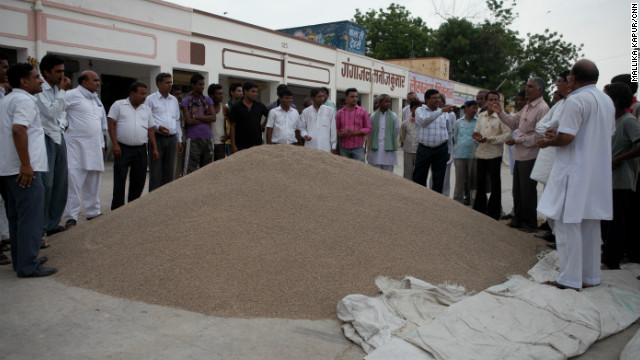Rajasthan, India (CNN) -- Rajinder Kumar has a spring in his step and a big smile on his face these days.
The 35-year-old farmer from Sri Ganganagar, a district in Rajasthan, northwest India, says life has never been better.
It's all because of what he grows in his fields -- a desert crop called guar.
"It's a miracle," he says.
Guar gum powder, made by crushing seeds of the guar crop, is used in a number of products in the food and cosmetics industries, including ice cream, breads, pastries, lipsticks and even diapers.
In just one year the price of guar has surged tenfold, from about 30 rupees (about 50 U.S. cents) to around 300 rupees for each kilogram of the precious seed.
Behind the phenomenal price rise is a surge in demand.
Oil and gas companies in the United States have developed a massive appetite for guar gum powder -- a key ingredient in a process called fracking, which is used to extract natural and shale gas from beneath the Earth's surface.
Guar gum powder has unique binding, thickening and emulsifying qualities which make it ideal for fracking, explains B.D. Agarwal, the founder and managing director of Vikas WSP, an Indian company that specializes in producing the product.
So far, oil companies have not been able to find a suitable substitute, he says.
Since 90% of the world's guar is grown in the desert belt of northwest India, local farmers in this poor area are enjoying the benefit of the guar rush.
Kumar says he had debts of almost $12,000. "I thought I'd never be able to pay it off," he says.
"There is a saying that in a house where there's no food, there are fights. We used to fight all the time."
But thanks to the high price of guar these days, Kumar has been able to pay off his debt. He's building a house for his family, has bought mobile phones, an air cooler and a satellite dish. He can afford to send his children to school. "We are all happy now," he adds.
Agarwal, meanwhile, is confident the guar rush will grow. He says shale gas reserves have been identified in 32 countries and 48 basins around the world, including India. Only the U.S. and Canada, and very recently Argentina, have attempted to extract it. China is expected to start fracking by the end of the year.
As demand grows, Agarwal predicts the value of the guar industry will jump, suggesting it could go from a $2 billion business today, to $200 billion by 2020.
So he's encouraging farmers like Rajinder to keep growing it.
In May this year, Vikas gave 15 kilograms of guar seeds to 200,000 farmers and guaranteed them returns.
"Everyone in the village is now growing guar," Kumar's wife, Dayawanti, says. "No one talks of anything else. It's changed the village. If you came here two years ago, you wouldn't see joy on anyone's face."
Her neighbors' house is bursting with joy. Musicians beat traditional drums to welcome guests as the community gets together to celebrate a marriage.
The bridegroom -- also a guar farmer -- says he would never have been able to afford this pomp if it wasn't for guar.
Locals call the little green bean "black gold" and in Sri Ganganagar, it's easy to understand why.

No comments:
Post a Comment